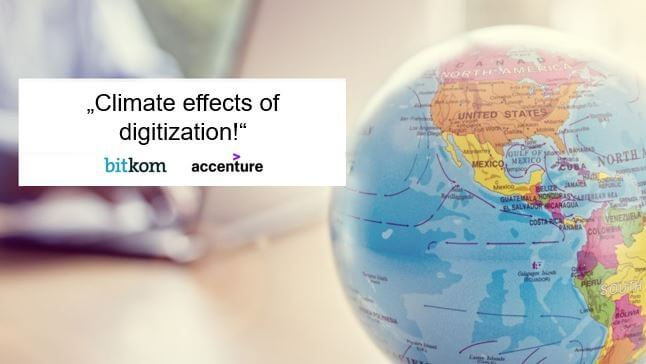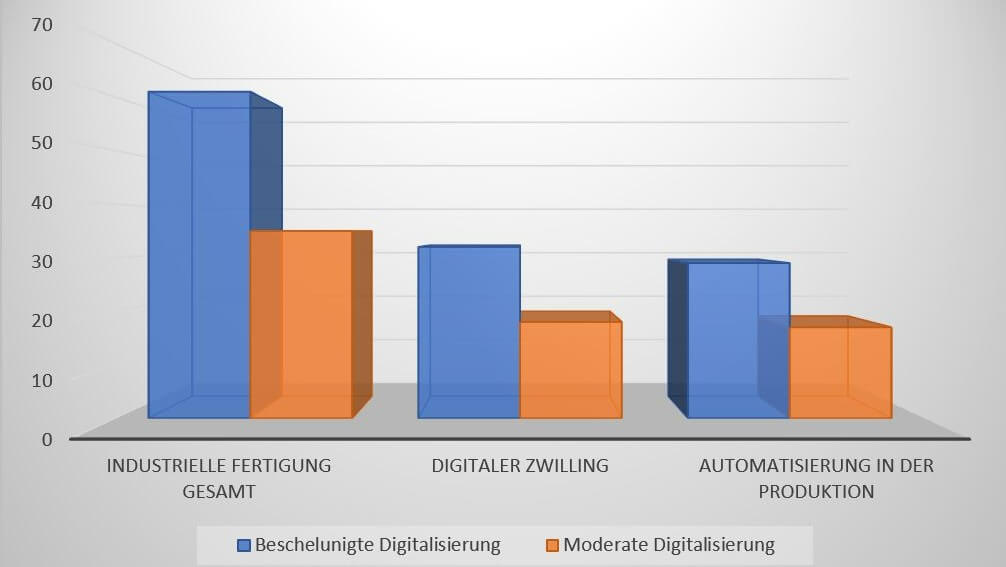Digital technologies offer a huge potential for more climate protection
Laura Reich Diez
What potential do digital technologies have in climate protection? The study "Climate Effects of Digitization" by Bitkom-Digitalverband, conducted by Accenture, shows that the potential for saving CO2 emissions is significantly greater than the CO2 footprint of digitization. Through targeted use, digital technologies can contribute almost 50% to Germany meeting its climate target by 2030.
The study looked at the seven application areas for digital technologies with the greatest potential for CO2 savings: industrial manufacturing, mobility, energy, buildings, work & business, agriculture, and health.
 Climate effects of digitization
Climate effects of digitizationThe speed of digital transformation is essential
The speed of digital transformations is the primary factor determining the contribution of digital technologies to climate protection. The study examines two scenarios: moderate digitization and accelerated digitization. In the case of moderate digitization, the pace of introduction and dissemination of digital technologies remains the same as in the past five to ten years. In the case of accelerated digitization, the pace picks up significantly as a result of appropriate political incentives.
The study examines two opposing climate effects of digitization: the CO2 savings potential that can be achieved with digital technologies in 2030 and the emissions caused by digital infrastructure in 2030.
Significant reduction of the CO2 footprint through the use of renewable energies
The digital infrastructure serves as the basis for accelerated digitization. The increased use of renewable energies forms the basis for climate-relevant digitization. Digital technologies have the greatest potential for CO2 savings in the area of industrial manufacturing. Through the digital twin and automation of production, 10-16% of the expected emissions for industrial manufacturing processes can be avoided. Expressed in figures: Up to 61 megatons of CO2 can be saved over the next ten years if digitization is accelerated - 35 megatons if the pace of digitization is moderate.
 blue: Accelerated digitization // organge: moderate digitization
blue: Accelerated digitization // organge: moderate digitizationCO2 savings potential of industrial manufacturing in 2030 (all figures in megatons)
Need for targeted and bold flanking measures by policymakers
Digital measures have been largely ignored in the German government's plans to date, even though they can make an immense contribution to climate protection. Bitkom President Achim Berg is calling for economic incentives from policymakers to promote climate-friendly and emission-saving technologies. What is needed now is targeted and courageous support from policymakers and decisive action by decision-makers at the top of the corporate ladder. Targeted and accelerated digitization can reduce CO2 emissions by 120 megatons in ten years. This corresponds to around one fifth of today's CO2 emissions.
We at 5-HT Digital Hub Chemistry & Health would like to thank Accenture and Bitkom for the newly gained insights regarding the potential of digital technologies in climate protection. Especially the savings potential in the field of industrial manufacturing is of great interest for digital chemistry. Nevertheless, this should not be an environmental conscience-soothing carte blanche for unbridled digitalization. For comparison, one tweet causes CO2 emissions of just under 300g in the current German electricity mix.
You can access the full study here.
Stay informed about 5-HT and the latest digital chemistry, health & sustainability news in our Newsletter: Newsletter - 5HT ()
5-HT Chemistry & Health Newsletter
Want the latest tech and industry news, events, relevant info from the ecosystem and more?
Subscribe to 5-HT Newsletter now Subscribe to 5-HT Newsletter now
Become part of the 5-HT Chemistry & Health
Exchange ideas with innovative startups and future-oriented companies in our ecosystem. We look forward to meeting you!